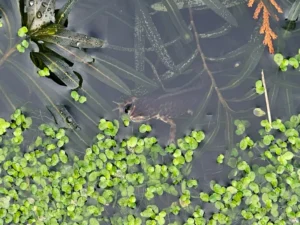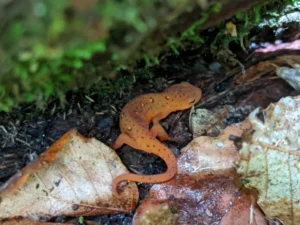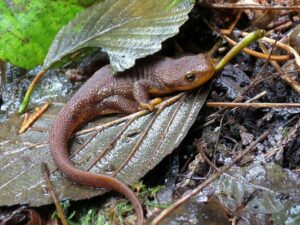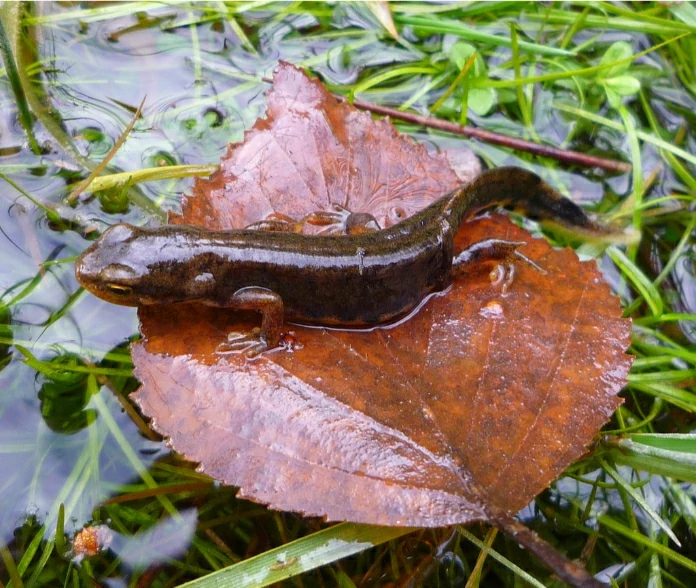Have you ever seen a tiny newt sliding across wet rocks or sitting quietly at the edge of a pond and wondered: does it always stay in water?
Newts do come out of water, but not all the time. They spend part of their life in water and part on land. Since they are amphibians, they need both environments to survive. Depending on the season, the species of newt, and what they need (like food, shelter, or mates) they might hang out more in one place than the other.
Why Newts Need Water in Their Life
Water is really important for newts, especially when it’s time to breed.
Most newts go back to ponds, lakes, or slow-moving streams to lay their eggs. Water gives their eggs a safe place to grow.

Without it, the eggs could dry out or get eaten by other animals.
Even when it’s not breeding season, many newts stick close to water. Their skin has to stay moist.
Unlike mammals, they don’t have scales or thick skin to keep water in. Their skin is thin, and keeping it wet is how they breathe.
Basically, water is like their lifeline.
When and Why Newts Leave Water
You might be wondering: if water is so important, why leave it at all?
Newts come out for a few reasons:
-
Finding food: On land, they hunt insects, worms, and other tiny animals living in soil or under leaves.
-
Avoiding predators: Sometimes water has fish or other threats. Going onto land can be safer.
-
Hibernation and shelter: In colder months, some newts leave water to hide under logs, rocks, or leaves. They stay damp, but they aren’t swimming.
Not all newts leave water the same way. Some stay mostly in ponds, while others wander farther onto land.

For example, the Eastern Newt in North America has a juvenile “red eft” stage where it lives on land for a few years before going back to water as an adult.
How Do Newts Move on Land?
Newts aren’t fast on land, but they get around pretty well.
Their legs are short and strong, letting them crawl over soil, moss, or damp leaves. They can squeeze under logs, hide in cracks, or climb over little obstacles.
Their skin stays wet as they move, and they’re careful, too dry, and their delicate skin can get hurt.
You might notice them moving slowly, almost like they’re checking every step. It’s not laziness, it’s survival.
Every move is careful so they avoid predators and stay wet.
Do Newts Go Back to Water Often?
Yes, even when they leave water, newts usually go back.
Some go back every day to soak and eat, while others stay on land for days or weeks, depending on the temperature and how wet it is.

When it’s dry or hot, they hide under damp leaves or logs. If it rains, they might come out to hunt, mate, or just explore.
Water is always a part of their life. Even when a newt is crawling in a forest, it “thinks” about water because that’s where it breeds and feels safest.
Does Season Change Whether Newts Stay in Water?
You might think newts stay in one place all year. Actually, they move differently depending on the season.
-
Spring and early summer: Adults go back to water to mate. Eggs are laid in water plants, and larvae hatch underwater.
-
Summer: Many young newts and some adults leave the water for a while to hunt on land. This is when they explore forests, meadows, and gardens.
-
Autumn and winter: In colder places, some newts hibernate on land under leaves, logs, or soil. Others stay in water under ice, but movement slows a lot.
Basically, newts are flexible. They change where they live depending on food, weather, and safety.
How Newts Find Safe Places on Land
Newts are tiny, so staying safe is really important. On land, they hide under leaves, stones, or logs.
Moist, shady spots are their favorite. Even a little puddle or patch of damp moss can be a temporary safe spot.

You might wonder: how do they keep from drying out? Their skin can soak up moisture from the ground around them.
By staying in damp spots, they can survive on land for days.
Some curl up under wet leaves and wait for rain to make hunting easier.
The Red Efts Almost Always Stay on Land
One of the best examples of newts on land is the red eft stage of the Eastern Newt.
After hatching in water, the larvae turn into tiny red efts. These efts leave the water completely and spend a few years living on land.
They hunt insects, worms, and other small animals, slowly growing before going back to water as adults.
This stage shows that newts aren’t just water creatures, they are real explorers, moving between two very different worlds.
What Risks Do Newts Face on Land?
Leaving water isn’t without danger. On land, newts face:
-
Predators like birds, snakes, and mammals
-
Drying out if they can’t find damp shelter
-
Getting trapped in gardens, roads, or fences
Still, newts are careful. They move mostly at night or when it’s wet, avoiding most daytime predators.
Their bright colors in some species also warn predators that they might taste bad.
Can You See Newts in Your Garden?
If you have a pond or damp soil, you might spot a newt crawling slowly among leaves or moss.
-
Look after rain or in the early morning.
-
Check under logs or stones near water.
-
Remember: they are small, shy, and mostly active at night.
Seeing a newt on land is exciting because it shows how flexible these little amphibians really are. They can live in two worlds and handle both, which is pretty amazing for such a tiny creature.
Conclusion
So, do newts come out of water? Definitely. But they do it carefully and for reasons that make sense for staying alive.
They hunt, hide, and explore on land, but water is still key for breathing, breeding, and safety.
Newts aren’t just pond creatures, they are flexible, careful, and surprisingly adventurous.
Next time you see one sliding across damp soil or hiding under a log, you’re seeing a creature that can survive in two very different worlds, just by being careful, patient, and clever.
Hi, my name is Ezra Mushala, i have been interested animals all my life. I am the main author and editor here at snakeinformer.com.

